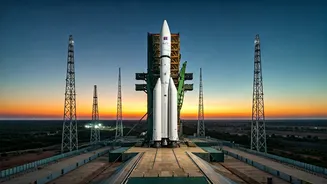LVM-3's Return
The Indian Space Research Organisation (ISRO) is primed to launch a communication satellite from Sriharikota on November 2nd, marking the eagerly awaited
return of its Launch Vehicle Mark-3 (LVM)-3 to the launch pad. This mission underscores the significance of the LVM-3, as it continues to prove itself as a reliable platform for launching satellites. The anticipation surrounding this launch is significant, not only because of the technology involved but also due to the symbolic nature of such ventures which highlight India's ambition and capabilities in the domain of space exploration and communication. The launch serves as a reminder of ISRO’s relentless commitment to innovation and expansion in space technologies.
The CMS-03 Satellite
The upcoming mission involves the deployment of the CMS-03 satellite, a communication satellite weighing approximately 4400 kg. This satellite is poised to be the heaviest communication satellite launched to a Geosynchronous Transfer Orbit (GTO) from Indian territory. Satellites in a Geosynchronous orbit have a pivotal role in ensuring constant communication services as their orbital period aligns precisely with the Earth's rotation. The advanced technological characteristics of the satellite reflect ISRO's advancements in enhancing communication capabilities and infrastructure. This launch is a critical step in ISRO's strategy to enhance and broaden its communication capabilities, facilitating better connectivity.
Vehicle Assembly and Integration
Prior to the launch, ISRO announced that the launch vehicle has undergone complete assembly and integration with the spacecraft. The vehicle has been moved to the launch pad, in preparation for the pre-launch operations. The precision of these preparations, from the assemblage of the vehicle to its integration with the satellite, mirrors the commitment to secure a successful outcome. The meticulous efforts reflect the importance of each phase for a successful space mission. The careful planning and execution of this project exemplify ISRO’s adherence to the highest standards of safety and operational efficiency.
Gaganyaan's Preparations
ISRO is not only focusing on satellite launches; it is also heavily involved in the Gaganyaan program, aimed at human spaceflight. The agency recently finished the first integrated air drop test for Gaganyaan at the Satish Dhawan Space Centre in Sriharikota. In this test, a simulated crew module equipped with a parachute system was released from a height of approximately 3 km using an Indian Air Force Chinook heavy lift launcher. ISRO is now gearing up for the inaugural uncrewed test flight of Gaganyaan. This is a crucial step towards the realization of human spaceflight capabilities.
LVM-3's Capabilities
The LVM-3 is designed to deliver spacecraft with a weight of up to 4000 kg. This launch is the rocket’s fifth operational flight (LVM3-M5). The LVM-3's past success includes the launch of Chandrayaan-3. The mission made India the first nation in the world to successfully land near the lunar south pole on August 23, 2023. This three-stage rocket signifies India’s prowess in advanced space technology. The ability to manage such a diverse array of missions shows LVM-3’s importance in ISRO’s space endeavors, making it a key component of India’s ongoing space programs.
Human Spaceflight Plans
The LVM-3 has been chosen by ISRO for the Gaganyaan program, India’s ambitious initiative for human spaceflight, scheduled for 2027. However, to meet the stringent requirements of human spaceflight, the rocket's systems have been reconfigured and it has been renamed the Human Rated LVM-3. The modifications reflect a deep commitment to ensuring the safety and reliability of the rocket for manned missions. The Human Rated LVM-3 is equipped to deploy the orbital module into a low earth orbit of 400 km, showcasing its role in ISRO's human spaceflight aspirations and its commitment to advancing space exploration capabilities.













